
宮崎レンズ(Ms-Opticsレンズ)の主な特徴
- コンパクトデザイン – 宮崎レンズはその小型かつ軽量な設計で知られている。これにより、持ち運びが容易で、さまざまな撮影環境に適している。
- 手動デザインプロセス – これらのレンズは手作業による緻密な設計プロセスを経て製作される。これにより、各レンズが特有の品質と個性を持つようになっている。
- 円形絞り – 独特の円形絞りは美しいボケ効果を生み出し、写真に独特の芸術的なタッチを加える。
- フルマルチコーティング – レンズに施されたフルマルチコーティングは、光の反射を抑え、画質を向上させる効果がある。
- 歴史的希少レンズ – 宮崎レンズは生産数が限られており、その稀少性が高い評価を受けている。
- 高解像度とコントラスト – これらのレンズは、高い解像度と優れたコントラストを提供し、鮮明でダイナミックな画像を捉えることができる。
- 低歪みと収差 – 光学的な歪みや収差が非常に低いため、写真は非常にクリアで歪みのない画像を提供する。
- 携帯性と実用性 – その携帯性と実用性の高さにより、日常的な使用やプロフェッショナルな撮影の両方に適している。
- Ms-Optics代表 宮崎貞安 – 宮崎貞安氏による情熱的で革新的なレンズ設計が、これらのレンズの独特の特徴を形成している。
宮崎レンズは独特で魅力的な特徴があり、写真愛好家や専門家の間で高い評価を受けている。
“Key Features of Miyazaki Lenses (Ms-Optics Lenses)
- Compact Design – Miyazaki lenses are known for their small size and lightweight design. This makes them easy to carry and suitable for various shooting environments.
- Manual Design Process – These lenses are crafted through a meticulous manual design process, giving each lens its unique quality and character.
- Circular Aperture – The distinctive circular aperture creates a beautiful bokeh effect, adding an artistic touch to photos.
- Full Multi-Coating – The full multi-coating on the lenses reduces light reflection and enhances image quality.
- Historically Rare Lenses – Miyazaki lenses are produced in limited quantities, making their rarity highly valued.
- High Resolution and Contrast – These lenses offer high resolution and excellent contrast, capturing sharp and dynamic images.
- Low Distortion and Aberration – With very low optical distortion and aberration, the photos provide exceptionally clear and distortion-free images.
- Portability and Practicality – Their portability and practicality make them suitable for both everyday use and professional photography.
- Mr. Sadayasu Miyazaki of Ms-Optics – The passionate and innovative lens design by Mr. Sadayasu Miyazaki shapes the unique characteristics of these lenses.
Miyazaki lenses have distinctive and attractive features, earning high acclaim among photography enthusiasts and professionals.”
― Production quantity of major Miyazaki Lens

Ⅰ. Ms-opticsレンズの特徴と魅力(Ms-Optics代表・宮崎貞安より)
-Features and Advantages of MS-optics Lenses (from Ms-Optics CEO, Sadayasu Miyazaki)
1) 最小サイズのレンズを目指して
すべてのレンズで金物、レンズサイズは極限まで小さく抑えられ軽く小型にデザインされている。
使用性、携帯性は同クラスレンズで群を抜いている。
例:Sonnetar 1.5 / 73ポートレート用長焦点レンズは、キャノン、ニコン、ツァイスの600gと比べ、195gと1/3の重さ、ISM 1.0 /50 GAはキャノン0.95 / 50の630gと比べ1/3以下の178gである。
35㎜~17㎜のワイドレンズは、大型のレトロフォーカス化をせずにレンズの厚みは、2.6~11㎜の超パンケーキデザインにまとめられている。
2) レンズ設計手法の工夫
多くのレンズメーカーのレンズは、コンピューターによる最高レベルの自動設計が行われ、どのメーカーのレンズも最高性能のコピーレンズなり、まったく無個性に感じられる。
一方、弊社Ms-opticsのレンズは自動設計を使うことがあるが、設計の後半は手動設計を主として、スポットダイアグラムと前後のボケを重視している。
古い収差のある有名レンズを敢えて手本にして、収差を残し、しかし上品に改良を行なっている。
大口径レンズでは、絞りの変化により、描写の変化を楽しめる様に敢えて開放で収差を残す様に心がけている。
3) 円形絞りの採用
レンズの絞りは小口径でも10枚、中口径で12~14枚、大口径では16枚と絞っても円型となり美しい丸いボケが得られる。ボケの美しさはMs-opticsレンズの大きな特徴の1つである。
4) フルマルチコートの採用
1面0.2%~0.3%の少ない反射のマルチコートを全面に採用することで、シンプルな2群レンズは透過率98.5%以上、4~5群レンズで透過率95~96%と優れている。
上記の性能により、発色の美しさ、抜けの良さもMs-opticsレンズの大きな特徴の1つである。
5) 歴史的レアレンズのきざし
アイテムの生産ロットは200個でのスタートを基本にしている。
この為価格は少々高めである。しかし、1アイテムで200~500個の生産でリピート生産も少ない為、中古市場では、弊社もびっくりするほどのプレミアム価格で売られている。
量産レンズの多くのものが2~3年で半額程になる昨今、使用後により高く売れる、これは弊社のお客様に対する最高のサービスであると自負している。
2022年5月5日 Ms-optics代表 宮崎貞安(記)
I. Features and advantages of Ms-optics Lenses (from Sadayasu Miyazaki, CEO of Ms-Optics)
1) Aiming for the smallest size lens
All lenses are hardware, and the lens size is designed to be light and small.
Usability and portability are outstanding among lenses in its class.
Example: The Sonnetar 1.5/73 portrait long focal length lens weighs 195 g and 1/3 the weight than those of the Canon, Nikon and Zeiss 600 g, and the ISM f1.0 /50mm GA weighs 178 g, less than 1/3 the 630 g of the Canon f0.95/50mm.
The 35mm~17mm wide lens has a 2.6~11mm ultra-pancake design without large retrofocus.
2) Devising lens design methods
Many lens manufacturers’ lenses are computer-designed at the highest level of automatic design, and lenses from any manufacturer are top-performing copy lenses, which feel completely unique.
On the other hand, our Ms-optics lenses sometimes use automatic design in the first stage of the development, but in the latter half of the design, we mainly design manually, focusing on spot diagrams and front and rear bokeh (blur).
It dares to model famous lenses with old aberrations, leaving aberrations but elegantly improving them.
With large-aperture lenses, I deliberately try to leave aberrations at full aperture so that you can enjoy the changes in the depiction due to changes in aperture.
3) Circular diaphragm
The aperture of the lens is 10 images even with a small aperture, 12~14 images in a medium aperture, and 16 images in a large aperture. The beauty of bokeh(blur) is one of the major features of Ms-optics lenses.
4) Full multi-coat
By adopting a multi-coating with low reflection of 0.2%~0.3% per surface on the entire surface, the simple 2-group lens has an excellent transmittance of 98.5% or more, and the 4~5-group lens has transmittance of 95~96%.
In addition, ghost analysis is performed, and the green and reddish-purple multi-coat suppresses reflection twice and has few ghosts.
Due to the above performance, the beauty of color development and good clarity are also one of the major features of Ms-optics lenses.
5) Signs of Historical Rare Lens
The production lot of items is basically based on 200 pieces as the minimum quantity.
Nowadays, many mass-produced lenses are dropped to be about half the price in 2~3 years, and we are proud that they sell at a higher price after use, which is the best service rendered for our customers.
May 5, 2022, Sadayasu Miyazaki, CEO of Ms-optics
Ⅱ. 現在の宮崎レンズの紹介 - Introduction of current Miyazaki Lens
1.HISTRIO-DARONAR 6.3/40
ゲルツのダゴールの現代的復元を追及。ダゴールは1905年、フォン・フーフによる設計ゲルツ社から発売された。暗いレンズであるがその高性能はトリプレット、テッサーをはるかに上回りスタジオ用、風景等作画用として高い評価が与えられた。当時のガラスが次々と生産中止の中、運良く入手可能であり復元設計が出来た。使用した硝材2種は近々無くなるため当レンズが最後のレンズになると思う。解像力、コントラストは前作プロター10~15%上回り開放で10µ以下、f8以上では5~8µ像に達する。
2群6枚の反射面4面すべてマルチコートにより98.5%の透過率で“生”の発色が美しい。歪曲収差は+0.13%距離による収差の劣化も大変少ない、上質のマクロ撮影に使用お勧めである。色数差はアポレンズ並みに補正されカラー、ノクローム共ににじみが少ない鋭く切れの良い画像が得られることもその理由である。
Pursuit of a modern restoration of Gertz’s Dagor. The Dagor was released in 1905 by the Görtz company, designed by von Hoof. Although it is a dark lens, its high performance far exceeds that of the Triplet and Tessar and it was highly evaluated for studio use and landscape drawing.
While the glass of that time was discontinued one after another, luckily it was available and a restoration design was possible. The two types of glass materials used will be gone soon, so I think this lens will be the final one. Resolution and contrast are 10~15% higher than the previous Proter, reaching less than 10μ at full aperture, and 5~8μ image at f8 or higher.
All four reflective surfaces of six elements in 2 groups are multi-coated for beautiful “raw” colors with 98.5% transmittance. Distortion is +0.13% and aberration deterioration is very small, so it is recommended for use in high-quality macro photography. The reason is that the color difference is corrected to the same level as that of the Apo lens, and a vivid and sharp image with little bleeding in both color and nochrome can be obtained.
レンズ仕様
レンズ形式 DAGOR型、F6.3 / 40, 2群6枚
全4面マルチコート
Focusing ∞~0.6m(0.85mまで距離計連動)
Filter M22.5 P0.75
LEICA M Mount
Size φ50㎜ x L 22.2mm
Wt. 50g Set. 55g
Lens Specifications
Composition: DAGOR Type F6.3 / 40, 2 group 6 elements
All 4 sides full multi-coat.
Filter: 22.5mm standard
Dimensions: Diameter Φ50.0 Thickness: 22.2mm
Focusing ∞~0.6m(0.85mまで距離計連動)
Filter M22.5 P0.75
LEICA M mount
Size φ50㎜ x L 22.2mm
Wt. 50g Set. 55g

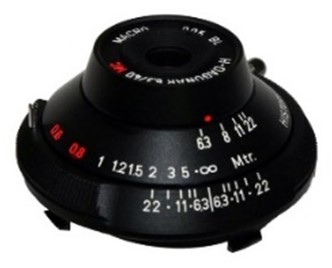
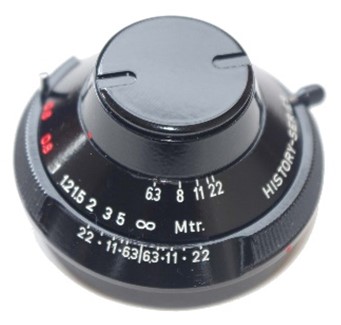
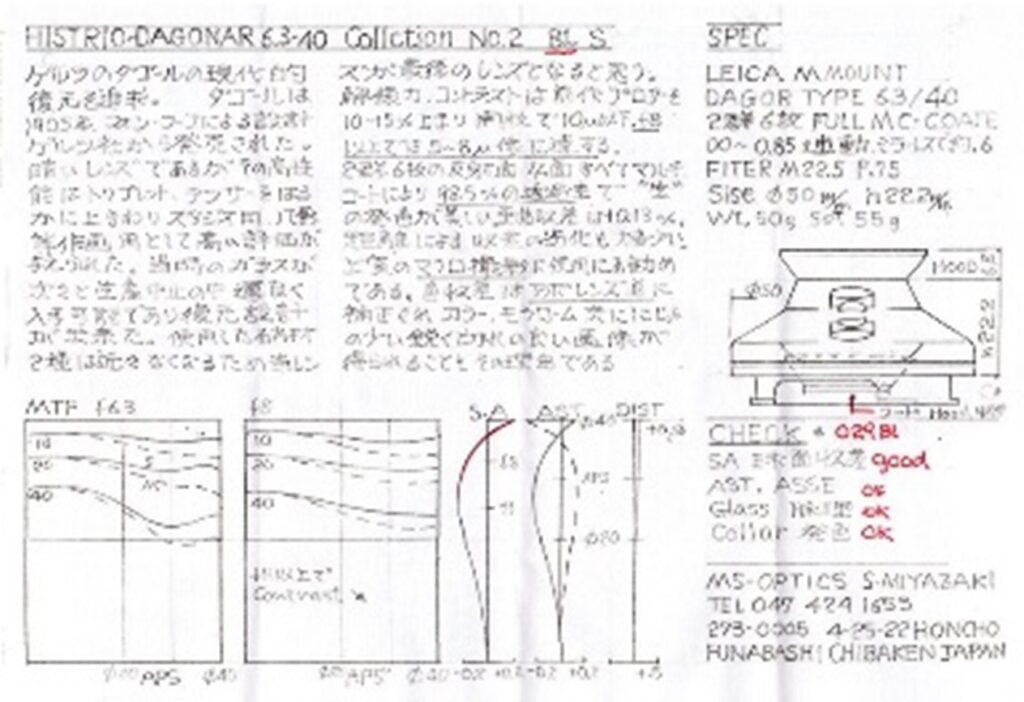
2.Prot f6.3 40mm
PROTARは1890年にZeissのRudolphにより設計された初のAnastigmat Lensである。球面収差、像面湾曲、Comaが補正された。大坂のM氏から送られたPROTARによる水玉の葉の美しい画像に魅了された、しかしf12〜18と大変暗い、ランタン系高折ガラスの使用でf6.3まで明るく出来、さらに旧レンズの収差特性=レンズの味もよく似たレンズが完成した。新時代準ワイド PROTAR Typ6.3/40レンズの発売に至った。像面湾曲、非点、コマの良さ、特に色収差の少なさは目を見張る。近代のガウス・テッサーを上回り、アポレンズに勝る。2-4Pのシンプルな形と全面MCCoatで、清純な美しい発色が得られる開放で十分なコントラスト、改造を有しF8で70%f11では100%回折限界に至る。SpotSize 中心7μ・中間10μ・周辺14μ、f11では全面5μ〜10μ像になります f16〜f22では回折によりコントラストが低下致します。当レンズはマクロレンズとして大変優れています、ディストーション、距離による収差の劣化が少なく理想的です。パンケーキ状のコンパクト超軽量にデザインされてスナップ・風景にお勧めします。
PROTAR was the first Anastigmat Lens designed by Rudolph from Zeiss in 1890 Spherical aberration, field curvature and Coma were corrected. I was fascinated by the beautiful image of polka dot leaves by PROTAR sent by Mr. M living in Osaka, but it was very dark at f12 to 18, and by using lantern-type high-fold glass, it was possible to brighten up to f6.3, and the aberration characteristics of the old lens = the taste of the lens was similar. A new era semi-wide PROTAR Type 6.3/40 lens has been released. The field curvature, non-point, and good frames, especially the low chromatic aberration, are remarkable. It surpasses the modern Gaussian Tessar and surpasses the Apolens. With a simple 2-4P shape and a full-surface Multi Coat, it has sufficient contrast and modification with an open aperture that gives a pure beautiful color, and reaches the 100% diffraction limit at 70% f8 and f11.
Spot Size Center 7μ, Intermediate 10μ, Peripheral 14μ, f11 results in a full-surface 5μ to 10μ image. In f16 to f22, contrast decreases due to diffraction. This lens is excellent as a macro lens, ideal with little distortion and aberration deterioration due to distance. It is designed to be compact and ultra-lightweight in the form of pancakes and is recommended for snapping landscapes.
レンズ仕様
レンズ形式 PROTAR型、F6.3 / 40, 2群4枚
全4面マルチコート
Focusing ∞~0.6m(0.85mまで距離計連動)
Filter M22.5 P0.75
LEICA M mount
Size φ50㎜ x L 16.2mm
Wt. 47g Set. 60g
Lens Specifications
Composition: PROTAR type, F6.3 / 40, 4 elements in 2 groups
Focal length :40mm
Filter: 22.5mm standard
Dimensions: Diameter Φ50.0 Thickness: 16.2mm
Mount: Leica M Mount
Wt. 47g Set. 60g
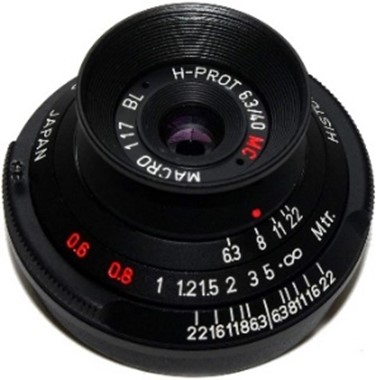
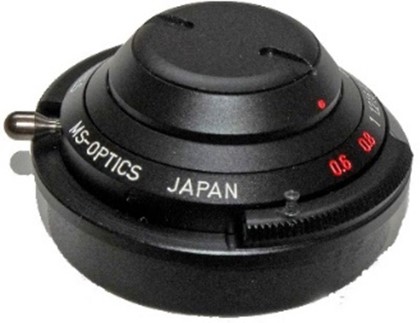
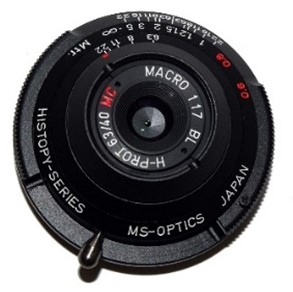

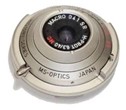

3.APOQUALIA 1.7/28
APOQUALIA 1.7/28大口径f1.7/28mmレンズで重さ60g厚み10.2mmは現在のレトロフォーカス型レンズの重さの1/3〜1/6、厚み1/4〜1/6と比べ驚き、軽量コンパクトと言えよう旅行・街でのスナップで目立たず機動性が発揮、ナイスショットにつながるf1.7でわずかなフレアーは室内のポートレートに適す。f2で中心のフレアーは消えf2.8で中間部までのコマフレアーも消失しぬけの良い写りは主題を強調できる。f4で解像力・コントラストは十分となりf5.6〜f8で全面パーフェクトになる。f8で2mに合わせると1m〜∞までのパンフォーカスとなりピントから解放されシャッターチャンスのみ集中できる。全8面にマルチコートを付け“生”の美しい発色が、又12枚円形絞りと非点収差ゼロ=S=Mにより像質、前後のボケは上品で美しい。36〜40cmまで近接できることも魅力の1つである。花、ペット、料理等の接写に適している。歪曲収差0.2%はレトロフォーカスレンズの1/10とマクロレンズ並、以上このレンズ1本で幅広いニーズに対応する万能レンズである。Lens Spec4郡6枚ガウス型LeicaM MountFull MCコートFL28.8 F1.73 Wt65g(set)Focusing ∞〜0.8m(非連動0.4m)Flter M34 HOOD内奥にネジ込み
APOQUALIA f1.7/28 is large aperture f1.7/28mm lens weighs 60g and is 10.2mm thickness, which is surprising compared to the current retrofocus lenses of 1/3 to 1/6 and 1/4 to 1/6 thickness, and it can be said that it is lightweight and compact, but it demonstrates inconspicuous mobility in travel and city snaps, and the slight flare at f1.7 that leads to nice shots is suitable for indoor portraits. At f/2, the central flare disappears, and at f/2.8, the frame flare up to the middle part also disappears, and the good image can emphasize the subject. Resolution and contrast are sufficient at f4, and it is achieved at f/5.6 to f/8 to the full. When you adjust to 2m at f8, the pan focus is from 1m to ∞, freeing you from focus and concentrating only on the photo opportunity.
Multi-coated all 8 surfaces provide beautiful “raw” coloring, 12-sheet circular aperture and astigmatism zero = S = M, and the front and rear blare are elegant and beautiful. One of the attractions is that it can be close to 36-40 cm. Suitable for close-up photos of flowers, pets, dishes, etc. The distortion aberration of 0.2% is 1/10 that of retrofocus lenses, which is equivalent to that of macro lenses, and this single lens is a versatile lens that meets a wide range of needs.
レンズ仕様
レンズ形式 PROTAR型、F6.3 / 40, 2群4枚
全4面マルチコート
Focusing ∞~0.6m(0.85mまで距離計連動)
Filter M22.5 P0.75
LEICA M mount
Size φ50㎜ x L 16.2mm
Wt. 47g Set. 60g
Lens Specifications
Composition: PROTAR Type F6.3 / 40, 2 group 4 elements
All 4 sides full multi-coat.
Focusing ∞-0.6m (Rangefinder linked up to 0.85 m)
Filter M22.5 P0.75
Leica M Mount
Size φ50㎜ x L 16.2mm
Wt. 47g Set. 60g
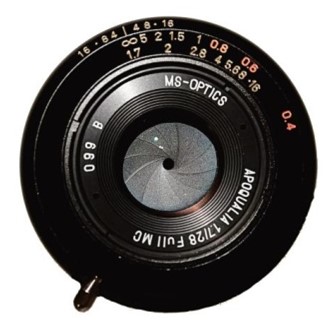
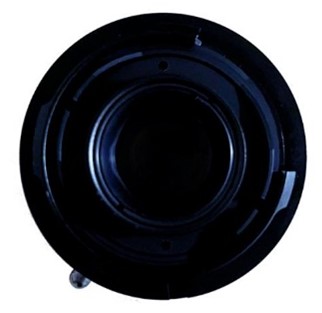

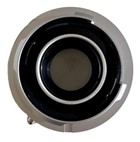
4.APORIA 2/24mm
New APORIA 2/24 APORIA 2/24mmの超薄型大口径ガウス型広角レンズである。 厚み5.8mm Wt45g!驚異の小形SiseにDesignされ、現在の大きく重いRetro Focus Lensと一線を画すGauss Typeは中間部から隅でComaフレアによるContrastの低下及び周辺光量の減少が欠点でこの改善に苦しんだが、このLevelなら満足できる性能に仕上げることが出来た。前後の大きなLensにNd1.8の高屈、低分散硝材を使いLens長12.8mmに抑えて隅での光量を確保している。 非点収差はASTに表示されるようにS.Mはπ35までピッタリ重なり、像質は丸く流れは全く無い。しかしこの事は大きい像面の湾曲を伴う?0.3mmは大口径Lensの-0.18の倍である。Mで曲線の〜は湾曲によるピントのズレによる。この癖を十分に考慮し作画する必要がある。f4〜5.6以上では深度が深くなり目立たなくなる。このLensの最大の魅力はBody Cap並の目立たぬLensと深いシンテンを生じ町の人々の生き生きした動きをSnapする事であろう。
New APORIA 2/24. This is an ultra-thin large-aperture Gaussian wide-angle lens of APORIA 2/24mm. Thickness is 5.8mm WT45g ! Designed in an amazingly small Sise and different from the current large and heavy Retro Focus Lens, the Gauss Type suffered from this improvement due to the reduction of contrast and peripheral light due to Coma flare from the middle to the corner, but we were able to finish the performance satisfactorily at this level. The large front and rear lenses are made of high-yielding, low-dispersion glass material of Nd1.8 to keep the lens length to 12.8 mm to ensure the amount of light in the corners. As for astigmatism, S.M overlaps perfectly up to π35 as shown in the AST, and the image quality is round and there is no flow at all. But this matter entails a large image field curvature?0.3mm is -0.18 times that of a large aperture Lens. The curve in M is due to misalignment of focus due to curvature. It is necessary to fully consider this habit when drawing. Above f4-5.6, the depth increases and becomes less noticeable. The biggest attraction of this Lens is that it snaps the lively movements of the town people by creating an inconspicuous Lens and a depth point like the Body Cap.
レンズ仕様
レンズ形式 ガウス型、F2.08 / 24.5, 4群6枚
全8面マルチコート
Focusing ∞~0.5m(0.8mまで距離計連動)
Filter M34mmのガラスをはずしフード内に装着する。
LEICA M mount(28㎜フレーム又は視界限界まで)
Size φ50㎜ x L 5.6mm
Wt. 39g Set. 45g
Lens Specifications
Lens format: Gaussian, F2.08 / 24.5, 6 elements in 4 groups
All 8 multi-coated courts
Focusing ∞~0.5m (linked with rangefinder up to 0.8m)
Remove the Filter M34mm glass and attach it to the hood.
LEICA M mount (up to 28mm frame or field of view)
Size φ50㎜ x L 5.6mm
Wt. 39g Set. 45g
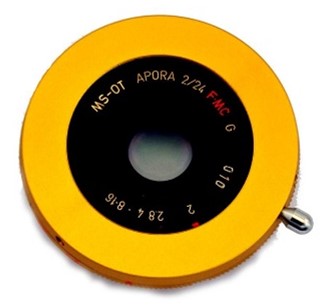

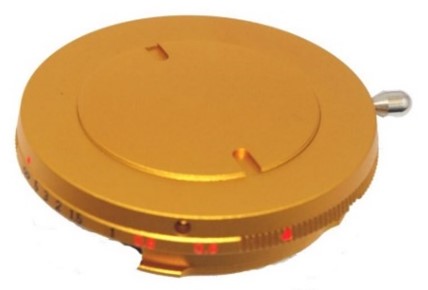
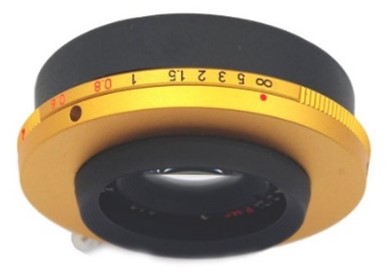
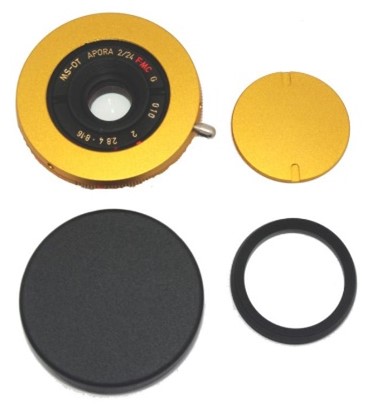
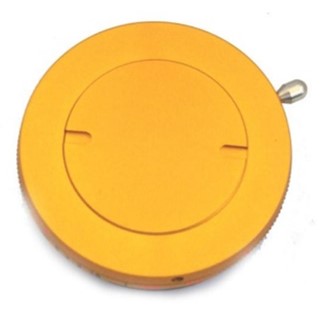
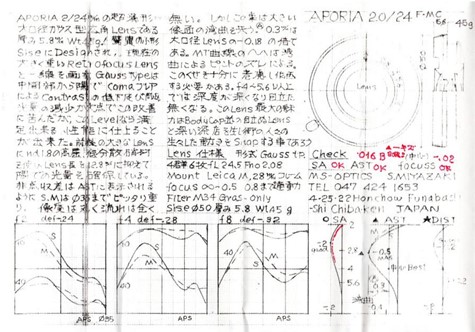
5.SONNETAR 1.3/50
Sonnetar1.5/50はツァイスへ移った天才ベルテレが1932年発明した大口径レンズ、3群7枚でコーティングの無い時代f1.5と合いまって抜群に明るくぬけの良さも7次収差による開放のシャープさで皆を驚かせた。 戦後一眼レフ時代ではバックフォーカスの短いこととコーティングの発明によりガウス型主流となりゾナー型レンズは50mmレンズから姿を消した。 独自性を重視する私としてゾナー型にこだわりガウスを超える高性能レンズを超える高性能レンズを目標に開発、 今回Sonnetar1.3/50を発売することとなった。125gの軽量、スリムタイプとして商品化できた。 全8面マルチコートとリアレンズのフローティングによるコマ補正でフレアーのない抜けの良い美しい色再現が、さらに球収差の7次補正による高い解像力によるシャープネスで高い性能を磨きかけた。 f2〜迄はシャープさが向上f4〜.6で最高レベルに達する。非点収差S、Mは接近して像形状は美しい。わい曲、Distも±0.35でゆがみは小さい。14枚絞りによりボケも美しい。
Sonnetar 1.5/50 surprised everyone with the sharpness of the opening by the seventh aberration, which is outstandingly bright and good with the goodness of wetness. It is by far bright and good at f1.5 under the era of no coating existed, and seven elements in three groups, with a large-aperture lens invented in 1932 by the genius Mr. Bertel who moved to Zeiss,. In the post war 2, when developing SLR, the short back focus and the invention of coating made it mainstream in the Gaussian type, and the zonar lens disappeared from the 50mm lens series. As I put priority my originality, I was particular about the zonar type and developed a high-performance lens that exceeds gauss, and this time we have decided to release Sonnetar 1.3/50.
It was commercialized as a lightweight thin type of 125 g. A beautiful color reproduction with good pullout without flare by frame correction by floating of all 8-sided multicoat and rear lens further polished high performance with sharpness by high resolution by 7th correction of ball aberration. Up to F2, sharpness improves to reach the highest level at f4 to 6. Astigmatic aberration S and M approach and the image shape is beautiful. Distortion is also ±0.35, which is minimum. The blur is also beautiful by 14 pieces of iris.
レンズ仕様
レンズ形式 ゾナー型、F1.37 / 50, 4群5枚
全8面マルチコート
Focusing ∞~0.8m
Filter M49mm P0.75 逆付け
LEICA M mount
Size φ50㎜ x L 35.7mm
Wt. 127g Set. 43g
Lens Specifications
Lens type: Sonnar type, F1.37 / 50, 5 elements in 4 groups
All 8 multi-coated courts
Focusing ∞~0.8m
Filter M49mm P0.75 Reverse
LEICA M mount
Size φ50㎜ x L 35.7mm
Wt. 127g Set. 43g
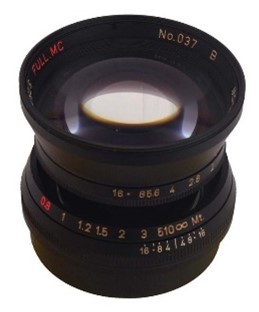
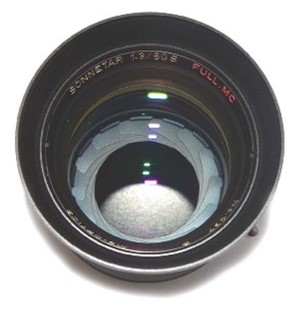
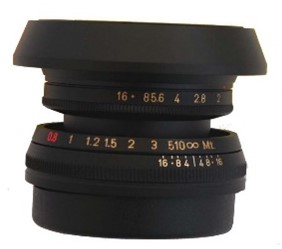
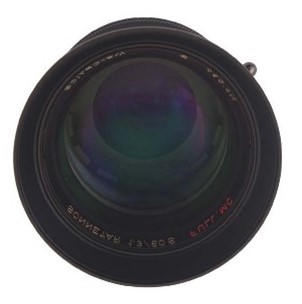
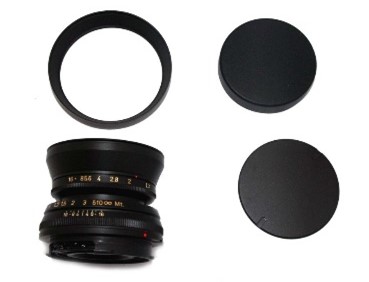
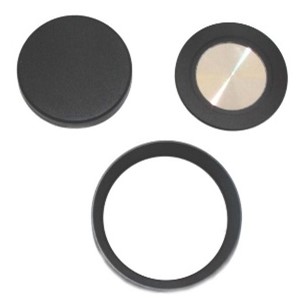
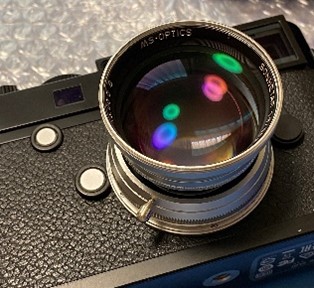
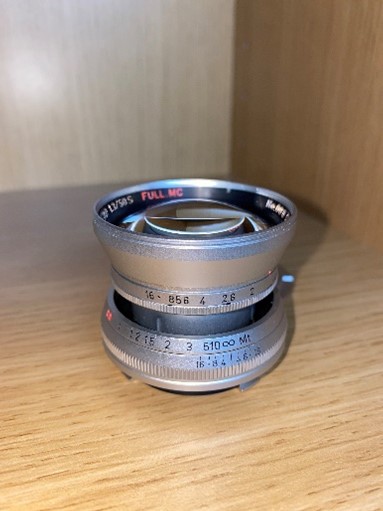
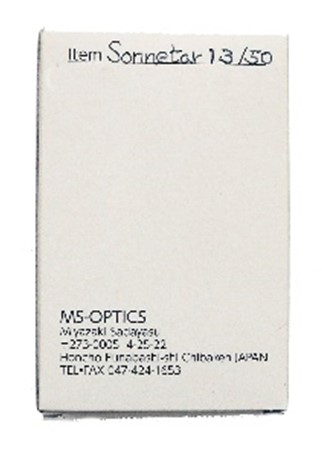
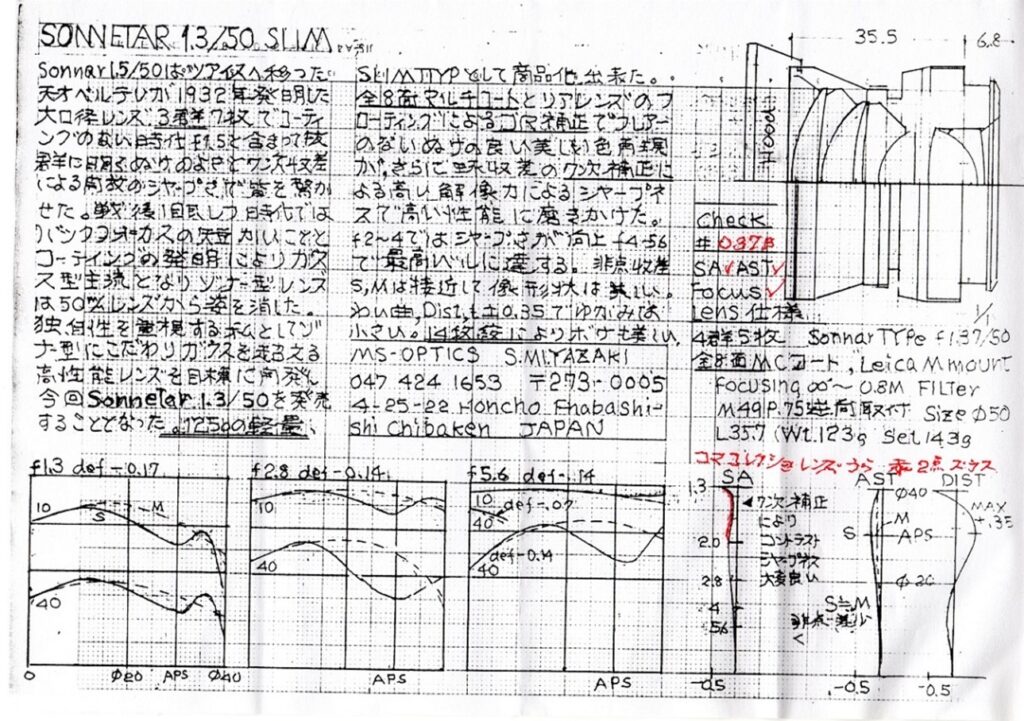
6.SONNETAR 1.5/73 MC
ズマレックス1.5/85、ズミルックス 1.4/75、キャノン1.5/85、ニッコール1.5/85、プラナー1.4/85、大口径ポートレートレンズである高性能かつボケの美しさからプロカメラマンに愛用された。アマチュアにとって高価なことから垂涎の的だった。私は差別的コンセプトを研究(1)超コンパクト、4群5枚のコンパクトでシンプルなゾナー型を採用鏡筒、ヘリコイドでもあらゆる固定常識を排除、薄型化、繰り出しの回転シングルヘリコイドの使用で目標をクリアその結果サイズπ50、L57、197g、驚異的超軽量、コンパクトデザインを実現できた。これらは今までレンズの容量で1/2、重さで1/2〜1/3の値となる。これによりフットワークの良い万能レンズとなった。 レンズ性能 開放では7次収差を与え淡いフレアによりポートレート用に利用をお勧め、f1.8で中心部フレアの高コントラスト、解像は他のガウスタイプと大きな差をつけるf2.8で十分、f4以上でパーフェクトレベル性能を有する。歪曲収差はMAX+0.2%複写レンズ並である。
Zumalex 1.5/85, Summilux 1.4/75, Canon 1.5 / 85, Nikkor 1.5 / 85, Planar 1.4 / 85, large-diameter portrait lens, which were favored by professional photographers due to its high performance and beautiful blur. It was covered target because it was expensive for amateurs. We researched a discriminatory concept and ultra-compact and simple Sonnar type with 5 elements in 4 groups are adopted. It is clear as a result and we could realize a surprisingly ultra‐light weight, compact design with the size of π50, L57 and 197g. Until now, the capacitance of the lens with good framework. It is recommended to use for portraits with low aberration and light flare at full aperture. At f1.8, it shows high contrast of centra flare and at f2.8, it shows enough for resolution than other Gaus type, which also performs perfect level of performance at more than f4.
Its aberration is Max. + 0.2 %.
レンズ仕様
レンズ形式 ゾナー型、F1.5 / 73, 4群5枚
全8面マルチコート
Focusing ∞~1m(0.8mまで距離計連動)
Filter. Hood M49mm P0.75 逆付け
LEICA M mount(28㎜フレーム又は視界限界まで)
Size φ50㎜ x L 57mm
Wt. 39g (他社の1/3の重さ)
Lens Specifications
Lens type: Sonnar type, F1.5 / 73, 5 elements in 4 groups
All 8 multi-coated courts
Focusing ∞~1m (linked with rangefinder up to 0.8m)
Filter. Hood M49mm P0.75 Reverse
LEICA M mount (up to 28mm frame or field of view)
Size φ50㎜ x L 57mm
Wt. 39g (1/3 the weight of other companies)
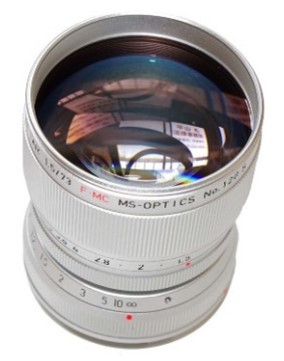
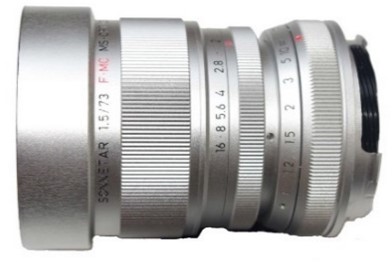
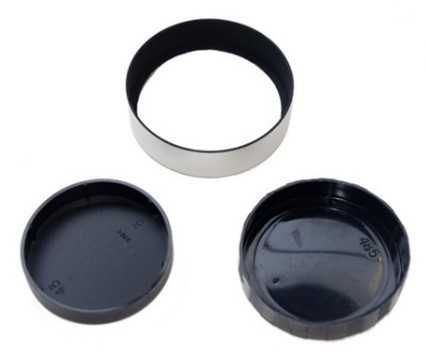
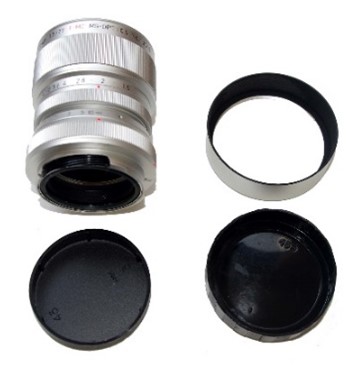
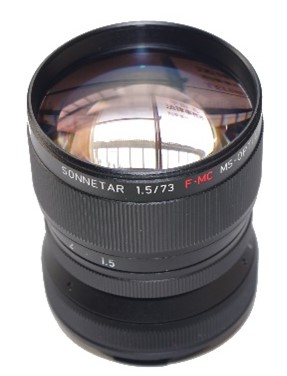
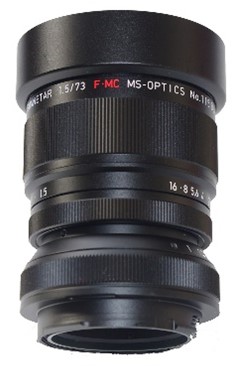
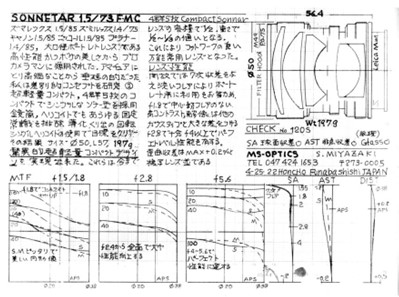
7. XENOMAX 3.5/50
シャープネス、コントラスト双方を最高まで追及するとクセノール型、ガウス型に行きつく。
クセノール型はトポゴンの血をひく広角レンズで、 Fuji GFX φ55(実際のセンサーサイズは44㎜ × 33mm)にも使えることからクセノールに決定した。
クセノールはローライフレックスに付けられ当時テッサ―タイプ全盛の中、ずば抜けた高性能で他のレンズを圧倒した。マイクロニッコールF3.5/50、ズイコー F3.5/50マクロ等高性能レンズは約20年売られ続けた。レンズシャッターカメラではヤシノン F2.8/45、フジノン F2.8/45は朝日カメラテストレポートで最高の評価を与えられた。
当レンズはf3.5開放から秀れf5.6で解析限界となりスポットダイアグラム3μ~6μ、MTFミリ40本で80→70に達する。下記表をみて(わかるとおり)、球面収差=SA、非点収差=AST、歪曲収差=DISTが大変優れている。MS-OPでNo.1の性能のレンズである。
If you pursue both sharpness and contrast to the maximum, you will end up with the Xenol type and Gaussian type.
The Xenol type is a wide-angle lens that draws on Topogon’s type, and I decided on the Xenol type because it can also be used with the Fuji GFX φ55 (actual sensor size is 44mm x 33mm).
The Xenor was attached to the Rollei flex and overwhelmed other lenses with its outstanding performance in the heyday of the Tessa type. High-performance lenses such as Micro Nikkor F3.5/50 and Zuiko F3.5/50 Macro continued to be sold for about 20 years. Among the lens shutter cameras, the Yashinon F2.8/45 and the Fujinon F2.8/45 were given the highest ratings in the test report by “Asahi Camera”.
This lens reaches the analysis limit at f5.6, which is excellent from f3.5 open, and reaches 80 to 70 with 40 MTF millimeters, with a spot diagram of 3μ to 6μ. Looking at the table below (as you can see), spherical aberration = SA, astigmatism = AST, and distortion = DIST are very good. It is the lens with the No. 1 performance among MS-OP’ s Lenses.
レンズ仕様
レンズ形式 クセノタール、F3.5 / 51.6 4郡5枚
画角ライカ 43°/ フジGFX 55°
Focusing ∞~0.55m 倍率1.8
フィルタ:34mm P0.75 逆付け
LEICA M mount
Size φ50㎜ × L33㎜ (沈胴時 L15.2mm)
重量63g(フード込み70g)
Lens Specifications
Lens format Xenotar, F3.5 / 51.6 4 groups 5 lenses
Angle of view Leica 43°/ Fuji GFX 55°
Focusing ∞ ~ 0.55m Magnification 1.8
Filter: 34mm P0.75 reverse mounting
LEICA M Mount
Size φ50mm x L33mm (L15.2mm when retro focusing)
Weight 63g (70g including hood)
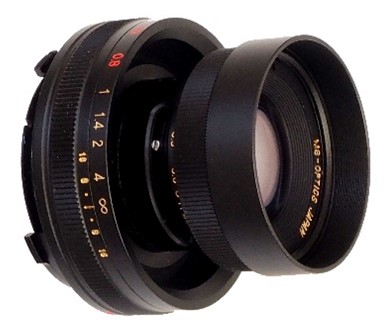
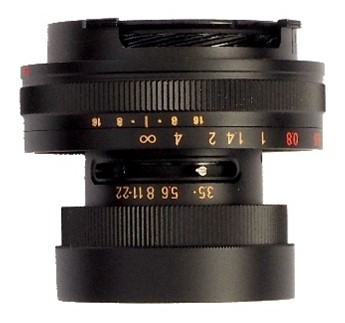
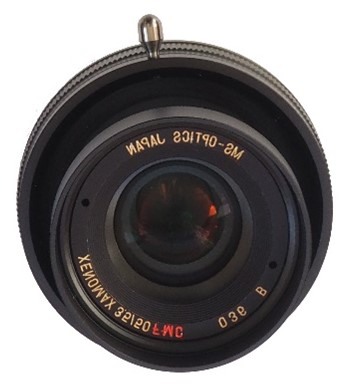
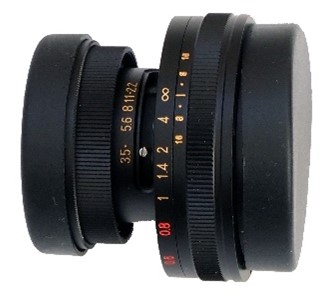


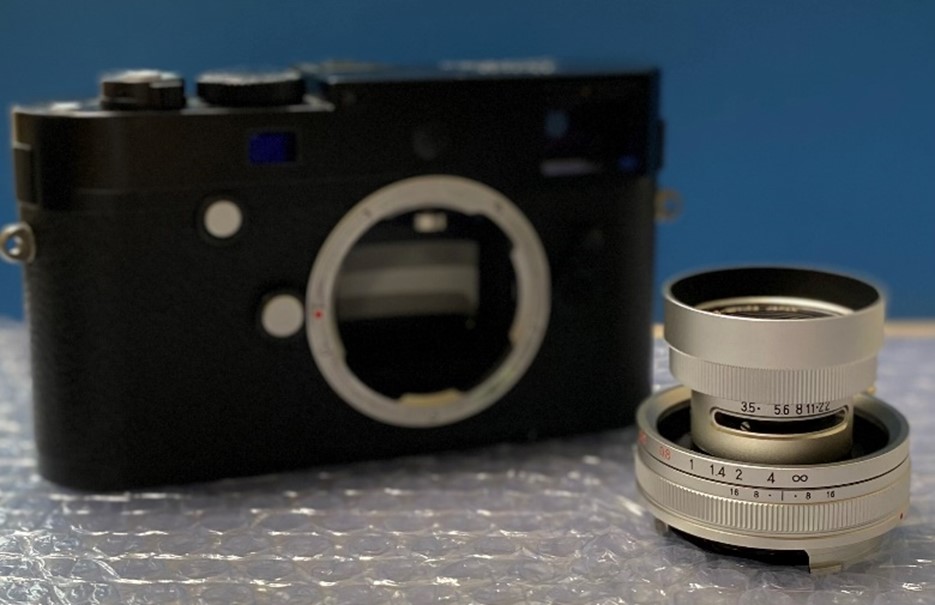

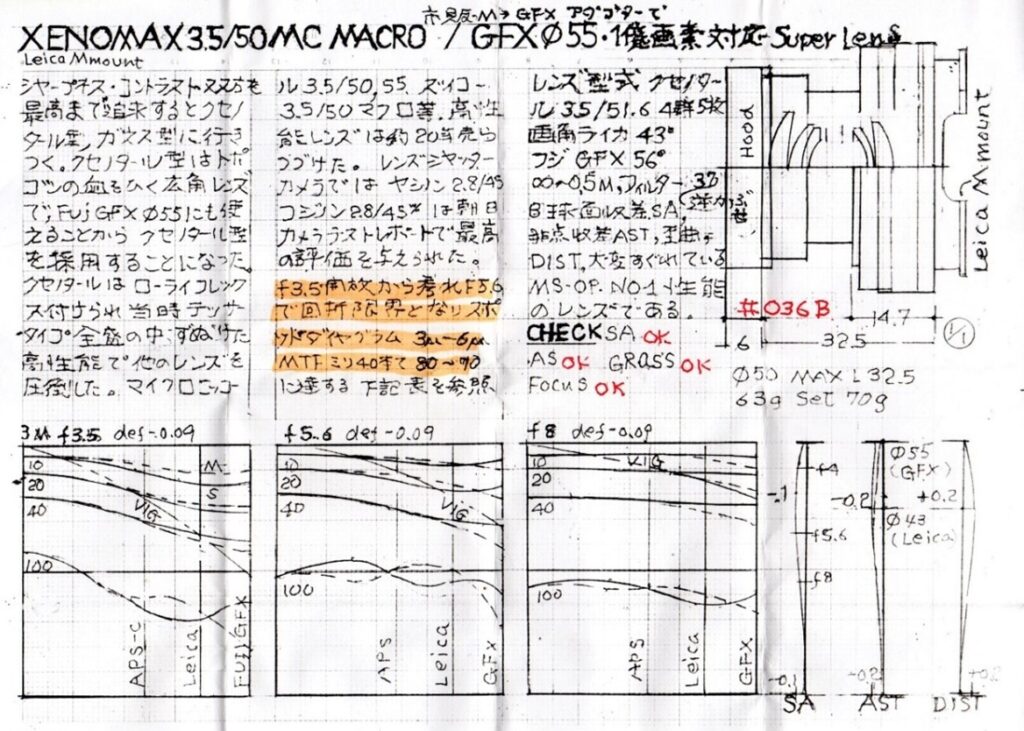
8. Vario Petz 2/57
Variable SoftFocus Portrait Lens
Vario Petz 2/57 球面収差(SA)可変Lens
当レンズはPetz 2/57の後部レンズを前後に約1mm動かし他の収差をほとんど悪化させる事なく球面収差だけを大きく変化させます。これによりキノプラズマート,ベス単レンズのようなSA補正不足、タンバール=SA過剰補正により ソフトな描写が得られます。中間0.Pointで球面収差、最小となり大変シャープな像が得られる。又、距離連動として使えます。他のPositionではFLの変化、ピント位置のずれによりミラーレス一眼専用となります。
SAポジションによる収差の変化-2~+2(中心部)
Rear後Lensをボールペンか爪楊枝でRingをゆっくり回し-2~+2まで合わせてください。
ポートレート用Lensとしてポジション+2、+1、0、-1、-2にセットソフトな人物像を楽しんで下さい。
-2:大きくフレアー芯はある、後ボケ美しい、f5.6フレアーCut、▲∞~2.5フォーカス不可
-1:f4でフレアーCut、▲∞~5mフォーカス不可
0:中心ハイコントラスト、解像力大M Leica距離計連動、∞~0.8mOK
+1:f4でフレアーCut、∞~1mOK
+2:フレアー大、前ボケ美しい、f5.6でシャープに、∞~1.2mOK
Variable Soft Focus Portrait Lens
Vario Petz 2/57 Spherical Aberration (SA) Variable Lens
This lens moves the rear lens of the Petz 2/57 back and forth by about 1 mm, greatly changing only the spherical aberration without aggravating other aberrations. As a result, soft images can be obtained due to insufficient SA correction like Quino plasmat and Beth single lens, and tambar = SA excessive correction. Intermediate 0. Spherical aberration at the Point is minimized and a very sharp image can be obtained. It can also be used as distance linkage. In other positions, it is only for mirrorless SLR due to FL changes and focus position shifts.
Change in aberration with SA position -2~+2 (center)
After rear position, slowly turn the Ring with a ballpoint pen or toothpick to adjust it to -2~+2.
Enjoy the soft portrait image set in positions +2, +1, 0, -1, -2 as a Lens for portraits.
-2: There is a large flared core, beautiful rear blur, f5.6 flare Cut, ▲∞ ~ 2.5 focus is not possible
-1: Flare Cut at f4, ▲∞~5m focus is not possible
0: Center high contrast, high resolution M Leica rangefinder linkage, ∞~0.8m OK
+1:Flare Cut at f4, ∞~1m OK
+2: Flare large, beautiful fore bokeh(blur), sharp at f5.6, ∞~1.2m OK
レンズ仕様
レンズフォーマット:Xenodar F3.5/51.6 4群5レンズ
画角: ライカ 43°/ 富士GFX 55°
フォーカシング∞~0.55m 倍率1.8
フィルター:34mm P0.75逆取り付け
ライカMマウント
サイズ :φ50mm × L33mm (レトロフォーカス時 L15.2mm)
重量: 63g(フードを含めて70g)
Lens Specifications
Lens format : Xenotar, F3.5 / 51.6 4 groups 5 lenses
Angle of view : Leica 43°/ Fuji GFX 55°
Focusing ∞ ~ 0.55m Magnification 1.8
Filter: 34mm P0.75 reverse mounting
LEICA M Mount
Size: φ50mm x L33mm (L15.2mm when retro focusing)
Weight: 63g (70g including hood)

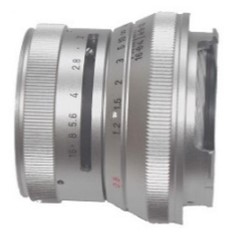

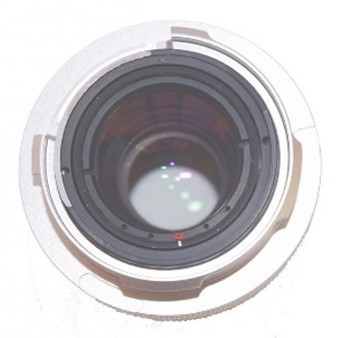
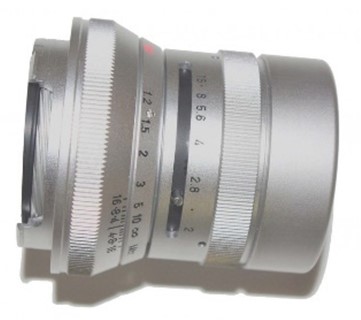
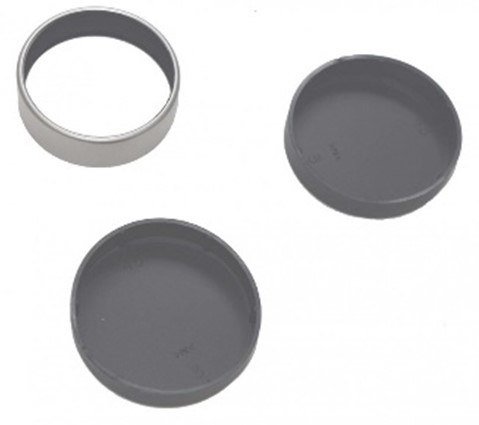
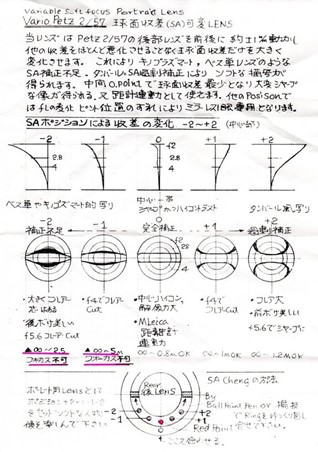
9. APOLLON 1.3/36
APOLLON 1.3/36 大口径超軽量小型広角レンズ 旅行・スナップ・ポートレート・接写など、これ1本で済むオールマイティレンズ。80g軽量小型です。レトロフォーカス型レンズの1/3~1/4の重さ、長さ/2携帯。撮影で大きなメリットです。Lens性能の向上、f1.3~2での解像力・コントラストを向上させ、中心一帯はフレアーの無い良好な像が得られます。 ガウス型の欠点である中間部からのコマフレアーによりコントラストの低下がありますが、解像力は優れています。f2~2.8でコマフレアーが消えコントラストが上がる。 全レンズにnd1.8の高屈折ガラスを使い、絞りに12枚の丸型絞りを使用しさらに非点収差を完全補正、全8面のMCコートをつける等の改良で美しい像と円形の良質の柔らかなボケを現実にした。f2.8~4ではコントラストとシャープネス双方共にでん面良像が広がります。f8~11で2m-8で申し分のない性能となります。f8~11で2m~∞までパンフォーカスになりファインダーをのぞかずスナップが可能です。また、30cmまでの接写もこのレンズの魅力です。
APOLLON 1.3/36 Large aperture ultra-light compact wide-angle lens. An all-purpose lens that requires only one lens for travel, snaps, portraits, close-ups, etc. It is 80g light and small. This us lens weighs at 1/3~1/4 than retrofocus type and length is 1/2. it is useful for carrying. It is a great advantage in shooting. Lens performance is improved, resolution and contrast at f/1.3~2 are improved, and a good image without flare can be obtained in the center area.
There is a decrease in contrast due to coma flare from the middle part, which is a disadvantage of the Gaussian type, but the resolution is excellent. At f2~2.8, the frame flare disappears and the contrast increases. All lenses use ND1.8 high-refractive glass, 12 round apertures are used for the aperture, astigmatism is fully corrected, and all eight MC coats are added to achieve beautiful images and high-quality, soft bokeh(blur) in a circular shape. At f/2.8~4, both contrast and sharpness expand the image of the good surface. At f8~11 by 2m-8m it shows perfect performance.
With f8~11, the pan focus is from 2m ~ ∞, and you can snap without looking through the viewfinder. Close-ups up to 30 cm are also an advantage of this lens.
レンズ仕様
レンズ形式 ガウス型、F /1.38 , 4群6枚
全8面マルチコート
焦点距離 36.2mm
Focusing ∞~0.3m(0.8mまで距離計連動)
Filter M34mmのガラスをはずしフード内に装着する。
LEICA M mount
Size φ50㎜ x L 22mm
Weight 80g
Lens Specifications
Lens format Gaussian, F/1.38 , 4 groups 6 elements
All 8 multi-coated courts
Focal Length 36.2mm
Focusing ∞~0.3m (linked with rangefinder to 0.8m)
Remove the Filter M34mm glass and attach it to the hood.
LEICA M mount
Size φ50㎜ x L 22mm
Weight 80g
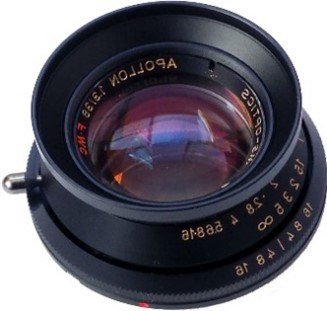
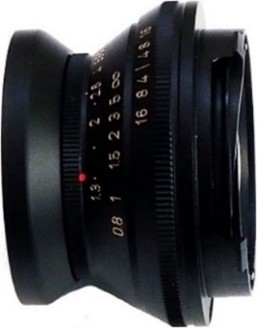
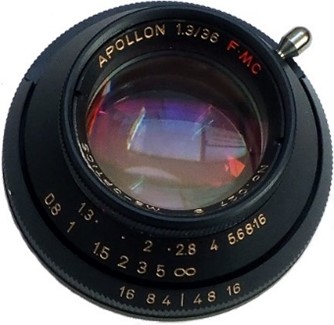


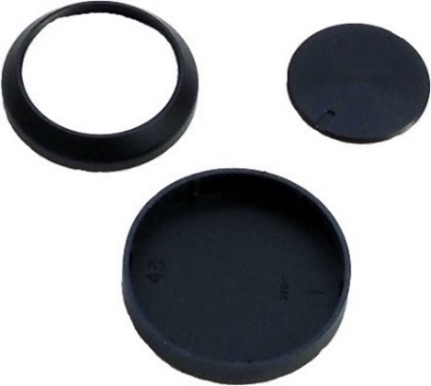
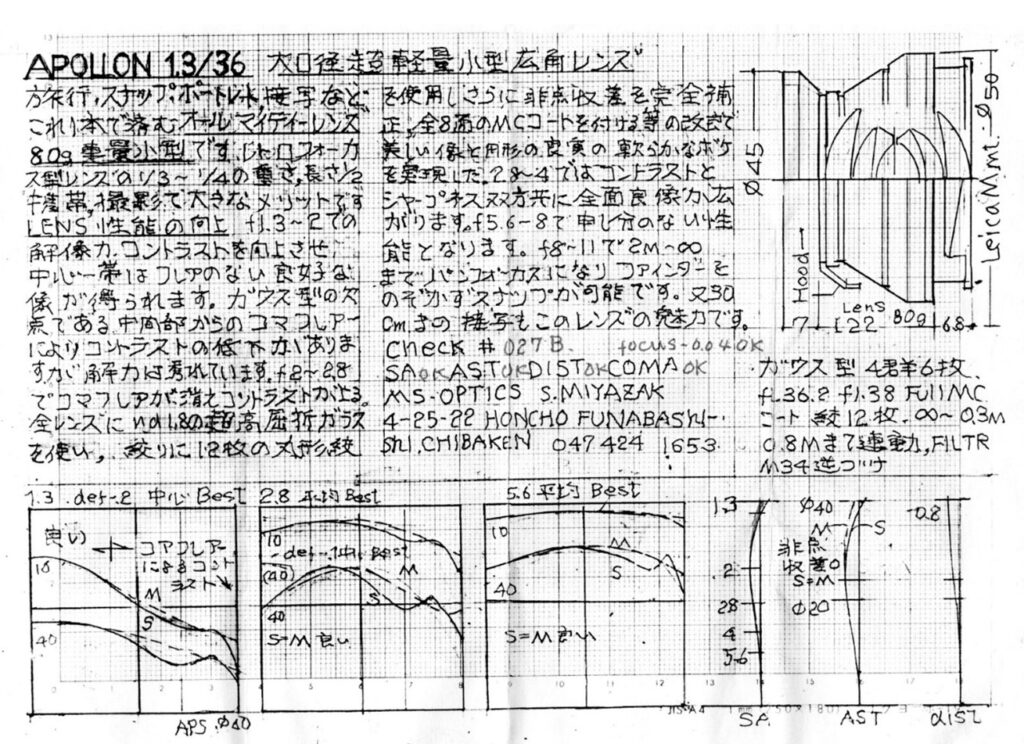
10. APOQUALIA 2/28
APOQUALIA 2/28 f2/28mm Lensは近年Retro Focus化と、非球面化により高性能になった。しかし、Lensの大型化でFootworkが悪い。常に独自性を“私は小型のGauss型にこだわり研究を続け、味のある、軟らかさのある私好みの性能が得られた。直径50厚み9.8mmでwtは50gの超Compact Designに仕上げることが出来た。非点収差=ASTを完全補正(像面湾曲は0.3mm残るが)ピントの合う位置で円形の美しい像と美しいボケを得た。色収差はAPO並に秀れ歪曲はRetro Focus Lensの1/5〜1/8で大変良好です。ガウス型に避けられない欠点S.Comaはさけられずf2〜2.5の中間〜隅でComaフレアが増加する。しかし直径20まではSharpness Contrastは良く中心の主題を強調します。中心-70°位置のピントズレは0.2mmあるがまずまずの値に抑えているが開放〜2.8で平面を撮ると気付くかもしれません。 当Lensの特徴・欠点を合わせ上手に使う事が重要です。F4以上に絞れば十分な特性となるオルマイティです。f2〜2.5がこのレンズの味が出る絞りです。直径20までの高コントラストと周辺の美しいフレアを利用して下さい。
The APOQUALIA 2/28 f2/28mm Lens has recently become more powerful due to Retro Focus and aspherical surfaces. However, Footwork is bad due to the larger size of the Lens. “I stuck to the small Gauss type and continued my research, and I was able to get the performance I am fond with taste and softness. With a diameter of 50mm and a thickness of 9.8mm, the weight was able to finish an ultra-compact design of 50 g. Astigmatism = AST fully corrected (although field curvature remains at 0.3mm) to obtain a beautiful circular image and beautiful bokeh(blur) at the focus position. Chromatic aberration is as good as APO, and distortion is very good at 1/5 to 1/8 of the Retrofocus Lens. The inevitable drawback of the Gaussian type S.Coma cannot be avoided and Coma flare increases in the middle to corner of f2-2.5. But up to 20 diameters, Sharpness Contrast emphasizes the central subject well. The focus misalignment at the center -70° position is 0.2mm, but it is kept to a reasonable value, but you may notice that if you take a plane at open to 2.8. It is important to use this lens skillfully by combining its features and shortcomings.
If you narrow it down to F4 or higher, it is an almighty that will be sufficient. The f2-2.5 is the aperture that tastes good of this lens. Take advantage of high contrast up to 20 diameters and beautiful flares in the periphery.
レンズ仕様
レンズ形式 ガウス型、f2 /28㎜ , 4群6枚
全8面マルチコート
焦点距離 28mm
フォーカス:∞〜0.9mインターロッキング0.9m〜0.75mミラーレス一眼レフ
LEICA M mount
Size φ50㎜ x L 9.8 mm
Wt. 50g Set.60g
Lens Specifications
Lens format Gaussian, f2/28mm, 4 Groups 6 elements
All 8 multi-coated courts
Focal Length 28mm
Focus: ∞ to 0.9m Interlocking 0.9m to 0.75m mirrorless SLR
LEICA M mount
Size φ50㎜ x L 9.8mm
Wt. 50g Set.60g
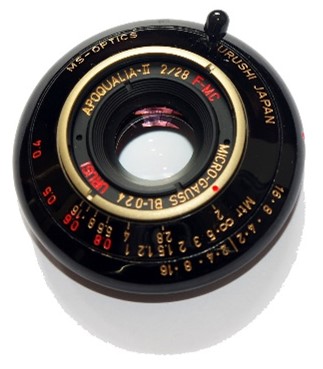
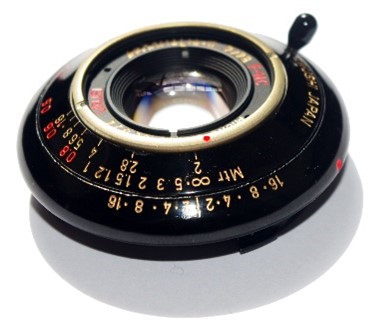



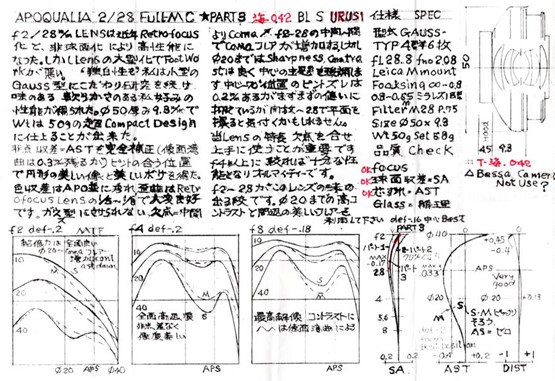
Ⅲ 主要な宮崎レンズ製造数 ― Production quantity of major Miyazaki Lens




